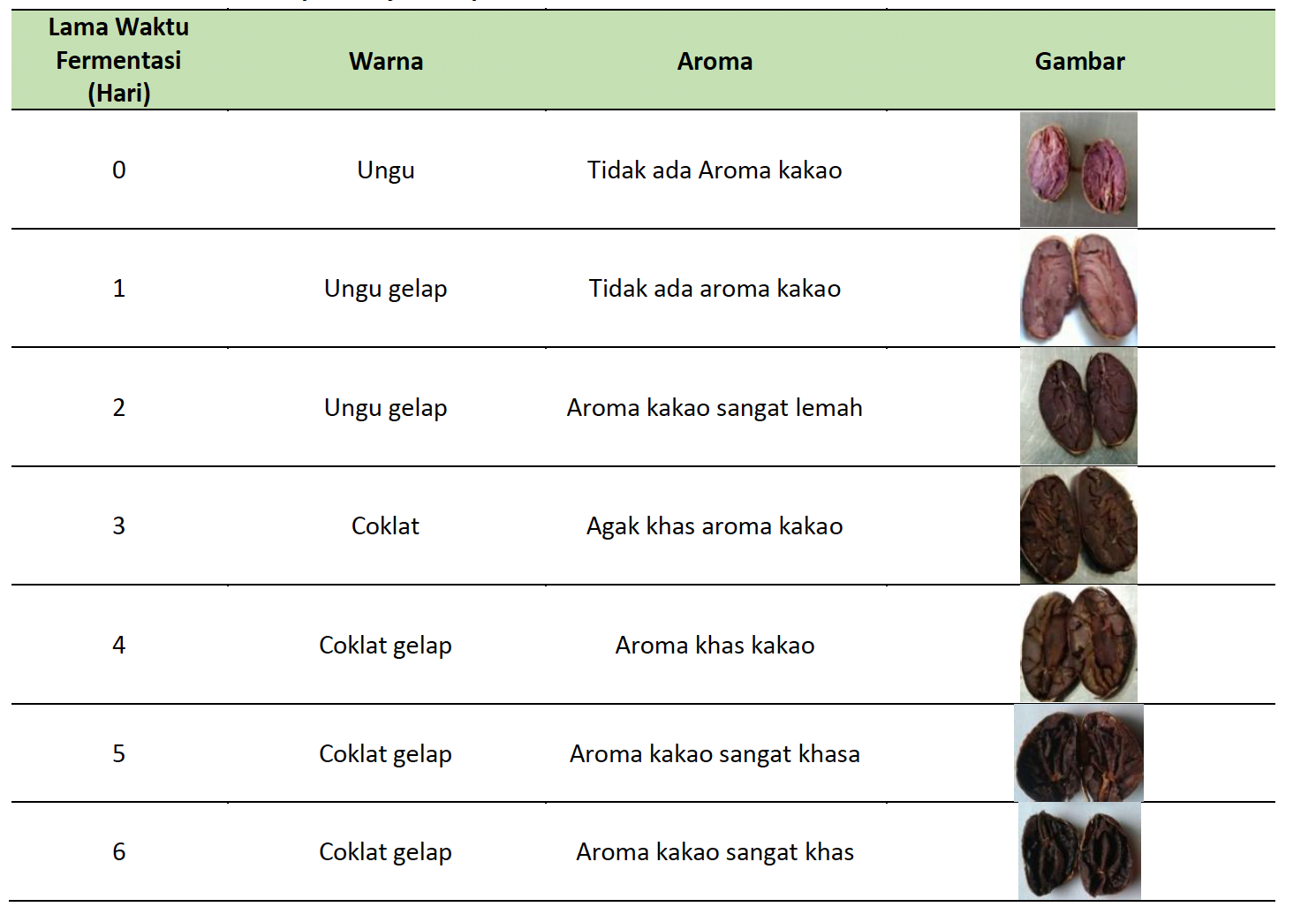Optimization of Cocoa Beans (Theobroma cocoa L.) Fermentation Time Using Tape Yeast Towards Antioxidant Activity with DPPH Method
DOI:
https://doi.org/10.36733/usadha.v4i1.7470Keywords:
cocoa bean (Theobroma cacao L.), fermentation, DPPH, IC50 valueAbstract
Cocoa beans (Theoborma cacao L.) are one part of the cocoa plant that is believed to contain high levels of polyphenol compounds that act as antioxidants. Cocoa beans are said to contain high polyphenol and flaovonoid compounds, which play an important role in the formation of antioxidants. Fermented cocoa beans have better quality in terms of taste, aroma, and color, but the fermentation process can cause a decrease in the content of polyphenol compounds in cocoa beans, causing a decrease in antioxidant activity. In the fermentation process, adding fermenters such as yeast tape can shorten the fermentation time. This study aims to determine the optimization of fermentation time to produce higher antioxidant activity of cocoa beans (Theobroma cacao L.) using the DPPH method. The results of the cocoa bean antioxidant test showed the IC50 value in the unfermented cocoa bean sample was 15.360 ppm, in the 1st day fermentation sample was 23.757 ppm, in the 2nd day fermentation sample was 3.574 ppm, in the 3rd day fermentation sample was 7.985 ppm, in the 4th day fermentation sample was 27.70 ppm, in the 5th day fermentation sample was 33.111 ppm, in the 6th day fermentation sample was 2.456 ppm, and in ascorbic acid as a positive control was 2.463 ppm. The data showed that the most optimum antioxidant value was found in the sample fermented for 6th days.
References
R. R. Utami, “Antioksidan Biji Kakao: Pengaruh Fermentasi Dan Penyangraian Terhadap Perubahannya (Ulasan),” J. Ind. Has. Perkeb., vol. 13, no. 2, p. 75, 2018, doi: 10.33104/jihp.v13i2.4062.
B. Zainal, M. A. Abdah, Y. Y. H. Taufiq, H. Roslida Abdul, and K. Rosmin, “Theobroma cacao: Review of the Extraction, Isolation, and Bioassay of Its Potential Anti-cancer Compounds,” Trop. Life Sci. Res., vol. 53, no. 9, pp. 21–42, 2016.
E. O. Afoakwa, A. S. Budu, H. Mensah-Brown, J. F. Tarama, and E. Akomanyi, “Changes in Biochemical and Physico-chemical Qualities during Drying of Pulp Preconditioned and Fermented Cocoa (Theobroma cacao) Beans,” J. Nutr. Heal. Food Sci., vol. 2, no. 3, pp. 1–8, 2014, doi: 10.15226/jnhfs.2014.00121.
C. Bruna, I. Eichholz, S. Röhn, L. W. Kroh, and S. Huyskens-Keil, “Bioactive compounds and antioxidant activity of cocoa hulls (Theobroma cacao L.) from different origins,” Journal of Applied Botany and Food Quality, vol. 83, no. 1. pp. 9–13, 2009.
A. Caligianti, M. Cirlini, G. Palla, R. Ravaglia, and M. Arlorio, “GC-MS Detection of Chiral Markers in Cocoa Beans of Different Quality and Geographic Origin,” Chirality, vol. 19, pp. 329–334, 2007, doi: 10.1002/chir.
G. A. Ariefta, G. G. Putra, and A. D. Anggreni, “Pengaruh Penambahan Ragi Tape Dan Waktu Fermentasi Terhadap Karakteristik Pulpa Biji Kakao,” J. Rekayasa Dan Manaj. Agroindustri, vol. 4, no. 2, pp. 42–52, 2016.
W. B. J. Barus, A. Anwar, M. Nuh, I. Gunawan, Mahyudani, and S. Ginting, “Pengaruh Jenis Ragi Dan Lama Perendaman.,” vol. 10, no. 2, pp. 292–303, 2021.
C. W. V Sucipto and Y. A. Handoko, “Analisis Perbandingan Kualitas Biji Kakao (Theobroma cacao L.) dengan Berbagai Wadah Fermentasi Menggunakan Kultur Campur,” Teknotan J. Ind. Teknol. …, vol. 16, no. 3, 2022, doi: 10.24198/jt.vol16n3.8.
C. A. Nuraskin, Reca, and T. Salfiyadi, “Identifikasi Ekstrak Metanol Biji Kakao (Theobroma cacao L.) Sebagai Bahan Dasar Pasta Gigi,” J. Mutiara Kesehat. Masy., vol. 7, no. 2, pp. 67–73, 2022, doi: 10.51544/jmkm.v7i2.3194.
D. Pratiwi and I. Wardaniati, “Pengaruh Variasi Perlakuan (Segar dan Simplisia) Rimpang Kunyit (Curcuma domestica) Terhadap Aktivitas Antioksidan dan Kadar Fenol Total,” J. Farm. Higea, vol. 11, no. 2, pp. 159–165, 2019.
P. E. Aikpokpodion and L. N. Dongo, “Effects of Fermentation Intensity on Polyphenols and Antioxidant Capacity,” Int. J. Sustain. Crop Prod., vol. 5, no. 4, pp. 66–70, 2010.
Prasanna & Arthi, “Hptlc finger print profile and in vitro antioxidant activity of Gomphrena Globosa L. Flowers,” Int. J. Pharm. Sci. Rev. Res., vol. 39, no. 1, pp. 208–215, 2016.
A. Suhardiman, “Pengaruh Tempat Tumbuh Tanaman Daun Gaharu ( Aquilaria malaccensis Lam ) dari Dua Daerah yang Berbeda terhadap Aktivitas Antioksidan The Effect of Plants Growing Agarwood Leaves ( Aquilaria malaccensis Lam ) from Two Different Areas on Antioxidant Activit,” no. May, pp. 8–16, 2023.
V. Arthi and G. Prasanna, “Hptlc finger print profile and in vitro antioxidant activity of Gomphrena Globosa L. Flowers,” Int. J. Pharm. Sci. Rev. Res., vol. 39, no. 1, pp. 208–215, 2016.

Downloads
Published
Issue
Section
License
Copyright (c) 2025 Usadha

This work is licensed under a Creative Commons Attribution-NonCommercial 4.0 International License.




